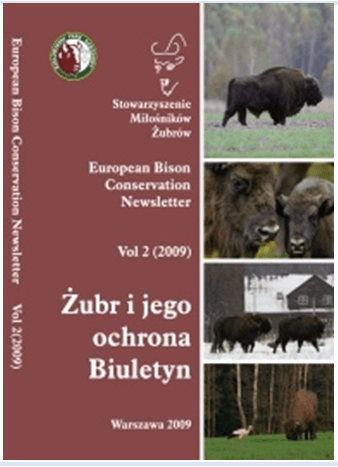Dictyocaulosis of European bison in Białowieża Forest
Keywords:
lung nematodes, genus Dictyocaulus, Bison bonasus, Białowieża ForestAbstract
Lung helminthosis also called dictyocaulosis caused by nematodes Dictyocaulus viviparus is one of most dangerous parasitoses of European bison. 36 bison in the age of 3 months to the age of 26 years shot during the eliminations in the 2 winter seasons 2007/2008 and 2008/2009 were examined for dictyocaulosis presence. Examined bison were divided up 2 age groups: up 2 years (19 animals) and over 2 years (17 animals). Fecal samples were taken directly from rectum. Faeces were examined using Baermann method. Intensity of invasion was defined on the basis of number of first stage larvae of D. viviparus in 5 gram of faeces. Lungs also have been necropsied directly by some sections of them and then the presence of nematodes in bronchi and bronchioles was examined. Altogether 94,4% of examined bison were infected with D. viviparus. Intensity of invasions ranged from 1 to 2730 larvae and mean intensity was 204. In the first age group 100% of animals were infected and intensity of invasion oscillated from 1 to 2730 (mean 426), than in the second age group infected were only 88,2% with intensity from 1 to 276 larvae (mean 42). It was observed that the size of the winter herd does not influence the intensity of invasion. It was determined that diagnostics of dictiocaulosis done by using the direct lungs necropsy by some sections of this organ are not precise and the results of this kind of examination are not credible. According to Baermann, the method worth recommendation is examination towards larvoscopy which allows to precisely define prevalence of invasion and intensity of infection. The invasion prevalence of bison caused by the D. viviparus nematodes found in the presented examination is the highest invasion prevalence ever registered among bison in Białowieża Forest. The mean intensity of infection is three to four times higher than in the earlier studies and maximal intensity is several tens higher. The probable reason of such a high prevalence and intensity of this invasion could be the too high density of bison in Białowieża Forest, and as an effect a significant accumulation of invasive larvae of this parasite in the environment. Obtained results allow to suppose that the number of ill and weak calves which should be eliminated will rise soon. So the permanent monitoring of the infected bison with dictiocaulosis in Białowieża Forest is necessary.
Downloads
Published
How to Cite
License
Copyright (c) 2009 Aleksander W. Demiaszkiewicz, Anna M. Pyziel, Jacek Lachowicz, Izabela Kuligowska

This work is licensed under a Creative Commons Attribution 4.0 International License.





